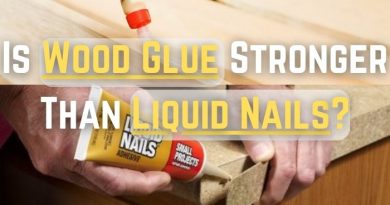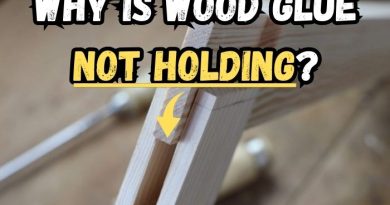Is Wood Glue Stronger Than Super Glue? Here is the Truth!
Wood glue and super glue are two of the most commonly used adhesives in woodworking and crafting. They both have their own unique strengths and weaknesses, and it can be difficult to determine which one is stronger.
Yes, wood glue creates a stronger bond than super glue for woodworking projects. Wood glue is formulated to deeply penetrate the porous structure of wood where it chemically cross-links with wood fibers for maximum adhesion. In contrast, super glue only bonds to the surface of wood.
Wood glue forms a bond that is stronger than the wood itself, whereas super glue forms a bond that is only as strong as the material it is bonding. However, super glue can be used in situations where wood glue is not suitable, such as bonding non-porous materials or in situations where a fast bond is needed.
Wood glue soaks deep into the porous wood material where it chemically cross-links with the fibers underneath. This leads to an incredibly strong adhesion that can even exceed the strength of the wood itself when clamped properly.
Super glue, on the other hand, only bonds to the outer surface of wood. So it doesn’t penetrate and reinforce the internal structure. Additionally, wood glue allows time for clamping to squeeze out air gaps, while super glue sets too quickly.
Given wood glue forms stronger, more flexible and water-resistant bonds through deeper penetration of the wood fibers, it seems like the better choice for furniture, cabinets and other wood constructions that will undergo stress and environmental changes over many years. Super glue may be sufficient for small, temporary repairs though.
So in summary, for your woodworking needs wood glue will likely provide a more durable bond and better ensure your projects last, making it the adhesive product you should use going forward.
Wood Glue Vs Super Glue
Bond Strength:
- Wood glue forms an incredibly strong bond when given time to fully cure, often as strong as or stronger than the wood itself. It penetrates deep into porous wood.
- Super glue sets almost instantly but produces a weaker surface bond that can fail over time under stress or with wood movement.
Durability:
- Wood glue bonds last for decades when used properly on wood furniture and projects. It remains flexible under stress.
- Super glue bonds have less flexibility and can crack or fail if wood expands/contracts or stress is applied to the joint.
Application:
- Wood glue works best for joining wood to wood and distributes pressure evenly during clamping. It requires clamping time.
- Super glue is best for small, non-structural repairs that don’t require clamping pressure. It sets almost instantly.
Water Resistance:
- Wood glue forms a fully water-resistant bond once cured, suitable for outdoor projects.
- Super glue bonds are not waterproof and can fail if exposed to moisture over time.
Uses:
- Wood glue is best for structural furniture construction and other projects requiring strong, durable bonds like cabinets, panels, furniture frames.
- Super glue is better suited for small indoor repairs, model/hobby applications, or filling cracks where strength is less important.
Comparison of Bond Strength Between Wood Glue and Super Glue
When it comes to bonding wood, both wood glue and super glue can be used. However, the strength of the bond will depend on the type of glue used and the type of wood being bonded.
| Application | Wood Glue Bond Strength | Super Glue Bond Strength |
|---|---|---|
| Face frame joints for cabinetry | Very strong | Moderate |
| Drawer box assembly | Excellent for long-term holding power | Weak, not suitable for structural joints |
| Gluing boards edge-to-edge for panels | Very strong and durable | Prone to failure, not suitable |
| Laminating thin stock for bowls/furniture | Strong and allows for clamping pressure | Weak bond that can fail over time |
| Repairing furniture breaks/cracks | Strong for rejoining wood | Works well for non-structural repairs and filling |
| Outdoor projects like planters | Water-resistant when cured provides lasting bonds | Not waterproof, bond will fail with weather exposure |
| Large woodworking projects like canoes | Not waterproof, the bond will fail with weather exposure | Not suitable, bond wouldn’t withstand stresses |
| Model ship/boat building | Strong for joining balsa/basswood and allowing sanding | Better for fillets than joining structural pieces |
When to Use Wood Glue
- Joining edges of boards/panels – Wood glue is ideal for edge gluing boards together to make panels, tabletops, etc. It forms a very strong bond.
- Assembling furniture frames – Using wood glue is essential for joining pieces like legs, rails, and aprons when constructing furniture frames that need to be durable.
- Attaching face frames to carcasses – Cabinet and furniture face frames rely on wood glue to securely bond them to the carcass/case pieces for years of use.
- Drawer construction – Both the drawer sides and bottoms are typically joined with wood glue for strength over the long-term opening/closing of drawers.
- Gluing dowels/biscuits – Wood glue provides reinforcement when used with alignment tools like dowels or biscuits during face frame or panel glue-ups.
- Laminating thin stock – Gluing thin layers of wood together with wood glue is a common technique for making thicker stock or panels.
- Outdoor projects – Wood glue forms water-resistant bonds ideal for outdoor furniture, planters, and other woodyard items that will see moisture.
- Repairing cracks/breaks – Wood glue can be used to rejoin broken or cracked wood pieces for restoration projects.
When to Use Super Glue
- Small repairs – Super glue sets almost instantly, making it ideal for gluing back loose trim pieces, cracks, broken ornamentation etc.
- Filling voids/holes – The thin consistency of super glue allows it to be used to fill small holes and voids in wood.
- Non-structural bonding – Since it doesn’t provide much strength, super glue is best for lightly stressed aesthetic bonds that don’t require clamping.
- Hobby/model building – The speed and small bond areas make super glue suitable for joining balsa, basswood and other materials in models.
- Glass or ceramic repairs – Super glue sets quickly to bond broken glass, ceramics, china and other rigid non-porous materials.
- Outdoor projects – While not waterproof, super glue can be used to bond small exterior pieces if protection from moisture is provided.
- Temporary bonding – It provides a quick bond for holding parts together during assembly that will later be joined more permanently.
It is important to note that super glue is not recommended for porous surfaces like wood. In fact, using super glue on wood can result in a weak bond that will break easily. Instead, a stronger bond can be achieved by using wood glue, also known as CA glue.
Is wood glue stronger than super glue for woodworking?
Yes, in most woodworking applications wood glue will provide a stronger bond than super glue. It is made to soak deep into wood and link together the tiny fibers. This makes the bond way stronger than super glue which just sticks to the outside.
Another good thing about wood glue is that it is thick. This allows you to squeeze out extra glue by pressing on whatever you glued with clamps. Super glue dries too fast for clamps on big areas. Without clamps, air bubbles cause a weaker bond.
Tests show wood glue pressed with clamps can be as tough as the wood itself. Super glue bonds are usually not as durable as the pieces glued together. That is why wood glue is better for furniture and other long-lasting wood projects where strength matters. You want your projects to last, so wood glue gives you a stronger bond that will not break.
| Application | Glue | Durability |
|---|---|---|
| Porous wood | Wood glue | Long-lasting, will last for years with proper application and care |
| Porous wood | Super glue | Bond fails quickly with moisture exposure or stress |
| Non-porous surfaces (metal, plastic) | Wood glue | Not as durable on non-porous surfaces, can fail with moisture |
| Non-porous surfaces | Super glue | Durable bond, but can fail over time from environmental stresses |
| Outdoor/weather exposed | Wood glue | Will last for years with proper cure and sealing |
| Outdoor/weather exposed | Super glue | Not suitable for long-term outdoor exposure |
| Heavy/high stress joints | Wood glue | Glue line remains flexible for years |
| Heavy/high stress joints | Super glue | Glue line is brittle and prone to cracking |
Is wood glue stronger than super glue for furniture?
For bonding wood together in furniture applications, wood glue will typically produce stronger joints than superglue. Here are a few key reasons why:
- Porosity of wood – Wood glue is formulated to penetrate deep into the porous structure of wood, where it chemically cross-links with wood fibers for an incredibly strong bond. Super glue only bonds to the surface.
- Clamping ability – Wood glue has a thicker consistency that allows for clamping pressure to be applied, squeezing out excess for maximum adhesion. Super glue sets too quickly for clamping in most cases.
- Water resistance – When fully cured, wood glue forms a water-resistant bond able to withstand humidity changes that occur in furniture. Super glue bonds are not waterproof and can fail with moisture exposure.
- Wood movement – Furniture woods expand and contract with temperature/humidity fluctuations. The flexible bond of wood glue is better able to accommodate this natural movement without failing. Superglue bonds are more brittle.
- Strength – Tests have shown properly applied wood glue can achieve shear strength equal to or even greater than the wood itself. Super glue bonds are not usually as strong as glued materials.
Conclusion
In terms of woodworking, wood glue is the preferred adhesive due to its strength and consistency. It is also easier to work with, as it can be sanded and painted over once it has dried. However, for other materials like plastic, glass, and metal, super glue is the better choice due to its versatility and ability to bond non-porous surfaces.




